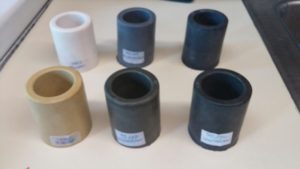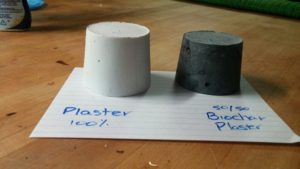In preparation for an upcoming workshop on Biochar From the Ground Up to be held at The Farm in Summertown, TN this week I have been experimenting with the use of biochar and different materials. While I’ve been researching biochar and cement for a few years and have blended char with other synthetic and organic materials, I haven’t had much exposure to plaster. Then I stumbled upon lots of different plaster and stone materials from my father’s former orthodontic offices and asked him to school me in the ways of making different plaster and stone composites. Once I had mastered that, adding in a bit of biochar was a no brainer.
To kick things off I made a 100% plaster sample and a 50/50 biochar plaster sample (see below) first blending the dry ingredients thoroughly before adding water. (Biochar particle size was <1/20”.) A few things are already interesting to note. The exothermic reaction that normally occurs with plaster during curing seemed completely absent with the biochar plaster which didn’t heat up at all. Also the volume of the blended model is smaller so the swelling which typically happens with plaster seems to have been minimized. And finally the weight of two samples was significantly different. When finished the all plaster sample weighed 5.2 ounces whereas the biochar plaster was 3.4 (it lost .2 ounces overnight), 34.6% lighter – not a bad thing when it is used in various building materials (e.g. gypsum drywall).
Water adsorption was pretty substantial in all biochar composites. Using a silicon mold to make cups, this was fairly easy to test and observe! It would be interesting to test various other properties of this composite such as fire, mold and sound resistance, insulation, hardness as well as curing time. To be continued!



